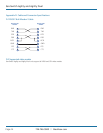
Appendices
724-746-5500 | blackbox.com
Page 43
C.6 Layer 2 and Layer 3: The OSI model
When discussing network switches, the terms Layer 2 and Layer 3 are very often used. These refer to parts of the Open System
Interconnection (OSI) model, a standardised way to categorise the necessary functions of any standard network.
There are seven layers in the OSI model (see Figure C-1) and these define the steps needed to get the data created by you (imag-
ine that you are Layer 8) reliably down onto the transmission medium (the cable, optical fiber, radio wave, etc.) that carries the
data to another user; to complete the picture, consider the transmission medium is Layer 0. In general, think of the functions car-
ried out by the layers at the top as being complex, becoming less complex as you go lower down.
LAYER
7L
AYER 7
LAYER
6L
AYER 6
LAYER
5L
AYER 5
LAYER
4L
AYER 4
LAYER
3L
AYER 3
LAYER
2L
AYER 2
LAYER
1L
AYER 1
Application
Presentation
Session
Transport
Network
Data Link
Physical
Network connection
Figure C-1. A representation of the seven layers defined by the OSI Model
As your data travel down from you towards the transmission medium (the cable), they are successively encapsulated at each layer
within a new wrapper (along with a few instructions), ready for transport. Once transmission has been made to the intended des-
tination, the reverse occurs: Each wrapper is stripped away and the instructions examined until finally only the original data are
left.
So why are Layer 2 and Layer 3 of particular importance when discussing ServSwitch Agility? Because the successful transmission
of data relies upon fast and reliable passage through network switches – and most of these operate at either Layer 2 or Layer 3.
The job of any network switch is to receive each incoming network packet, strip away only the first few wrappers to discover the
intended destination then rewrap the packet and send it in the correct direction.
In simplified terms, the wrapper that is added at Layer 2 (by the sending system) includes the physical address of the intended
recipient system, i.e. the unique MAC address (for example, 09:f8:33:d7:66:12) that is assigned to every networking device at
manufacture. Deciphering recipients at this level is more straightforward than at Layer 3, where the address of the recipient is rep-
resented by a logical IP address (e.g. 192.168.0.10) and requires greater knowledge of the surrounding network structure. Due to
their more complex circuitry, Layer 3 switches are more expensive than Layer 2 switches of a similar build quality and are used
more sparingly within installations.


















